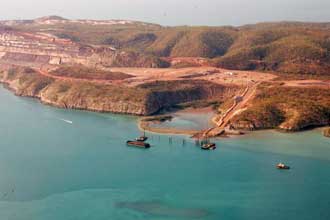Koolan IslandLike neighbouring Cockatoo Island, Koolan Island holds deposits of high grade iron ore and has been mined for its or since the late 1940s. At that time, BHP commenced open-pit mining operations on Koolan and neighbouring Cockatoo Island and by 1963 had established substantial mining operations there.
The Koolan Island mine closed in 1994 after BHP had extracted 68 million tonnes of high-grade haematite ore averaging 67% iron. In June 2006, exploration company Aztec Resources, which holds exploration and mining licenses over the island and some of the adjoining mainland, announced the reopening of the mine which it claims as holding some of the richest and purest iron in the world, containing between 67% and 69% iron, with low contaminants in the form of silica, phosphorus, aluminium and sulphur.
In 2007 Aztec Resources sold the mining rights to the island to Mount Gibson Iron, after significant cost overruns, subsequently calling the feasibility of the project into question, however the mine continued to operate.

In April 2006, the company signed a co-existence agreement with the Dambimangari (Dambima-Ngardi) indigenous Australian traditional owners of the island. The agreement aims to ensure that 3% of the 220 person workforce is filled by indigenous people by the eighth year of operation.
When BHP ceased mining operations on the island in 1993 they flooded the Main Pit to the ocean by blasting part of the hanging wall. This has meant that the pit has been filled with approximately 10 billion litres of sea water, with a significant marine eco-system forming within the bounds of the former working pit.
Where is it?
Koolan Island is situated off the Kimberley coast of Western Australia in the Buccaneer Archipelago. It is about 1,900 km north of Perth, and about 130 km north of Derby.
Due to the dense nature of the marine fauna within the Main Pit, Mount Gibson Iron utilised numerous substantial blasts within the water filled pit in order to extract all marine creatures before dewatering operations were commenced. A Seawall was then built around the ocean side of the pit in order to keep the ocean out. The pit was subsequently dewatered in order to allow the rich ore reserves to be mined once again.

Design by W3Layouts | Content © 2013 Phoenix Group Co. | Sales: phone 1300 753 517, email: [email protected]

